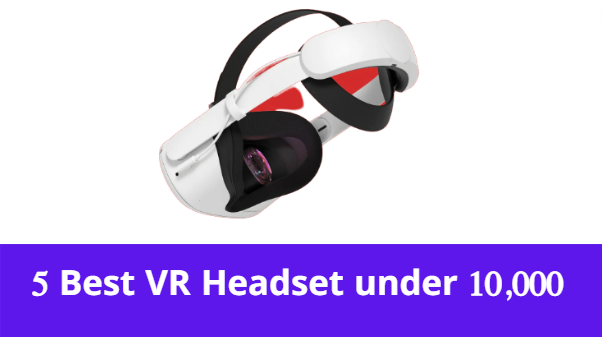You’ve come to the right place if you’re looking for the best VR headset under 10,000. Over the last few years, the virtual reality headset market has grown leaps and bounds, giving buyers more options. Whether you want an HTC Vive, Oculus Rift, or something more specialized like a Hololens, there’s bound to be something that meets your needs and fits your budget. Here are our top five picks for the best VR headsets under 10,000.
Virtual reality was still too expensive and alienating to take over the gaming world. However, now that everyone is talking about the metaverse, the virtual reality scene is getting much attention. There are new apps and games and new hardware and use cases. The Meta Quest 2 (formerly known as the Oculus) is now just as useful for work as it is for fun.
It’s an exciting time to get into virtual reality. But before we get started, there’s one thing you need to know: Do you want a headset that is tethered or wireless?
Products | Features | Rating | Price |
1.Oculus Rift S VR Gaming Headset |
| ||
2 .DESTEK V5 Virtual Reality Headset |
| ||
3 . VR SHINECON-Virtual Reality Headset |
| ||
4 .PVR Headset Virtual Reality Headset 3D |
| ||
5 .Voxkin Virtual Reality Headset 3D VR Glasses |
| ||
Is It Better To Use Tethered Or Wireless Virtual Reality?
Because you’re connected to a PC, tethered VR provides more graphical detail. The disadvantage is that you’re tethered to a computer. There’s no avoiding that cables are inconvenient to work with, especially when you can’t see them. You’ll probably trip over them as well. However, if you want top-of-the-line graphics and have invested in a great gaming PC or laptop, you’ll want to stay tethered.
Wirefree VR is a much better option for most people, including myself. It’s more comfortable, and you won’t get tangled up in your cables. It’s also completely portable. Wirefree VR headset can be set in any house room without the need for a computer. In the case of the Meta Quest 2, you can also connect it to a PC for additional graphical power. Both types of headsets are shown below. Take a look around.
How Do You Pick The Best Virtual Reality Headset For You?
Because the market is heavily segmented by price, deciding on the best VR headset for you will most likely come down to your budget. If money is your only consideration, you’ll find a list of the best VR headsets in each price range just below, but if you’re looking for the best VR headset under 10,000, there’s a lot more to this story.
Aside from price, a few features distinguish budget, mid-range, and high-end headsets: the most common display resolution, screen type, FOV, and traceability support.
1-The Size of the Screen
In most cases, the best VR headset is the one with the highest resolution. The solution is an essential part of the virtual reality experience. A high-resolution display will eliminate the screen door effect, making your games feel more fresh and immersive. If you’re going to spend more than $600 on a headset, make sure it has a resolution of at least 3664 x 1920.
2-Type of Panel
Because of the increased color contrast and vividness, VR headsets are quickly adopting OLED displays. It might be worth waiting for the perfect headset with an OLED panel if you want to stay on top of new developments (many of the best options today still use an LCD).
3-Viewing Angle
The best VR headsets have an average field of view of around 100 degrees, with variations of about 10 degrees. The higher the field of view, the more you’ll be able to see around you, and the more accurately the headset will mimic natural human vision. If you want to use your VR headset for gaming, make sure the temperature is between 100 and 110 degrees.
4-Support for Tracking
Onboard cameras in cheaper VR headsets track their position and your heads within a virtual world. On the other hand, more expensive devices frequently use additional hardware such as the following bases to set up room-scale tracking with far greater accuracy. You can play games on a headset with onboard monitoring, and if you’re looking for some light entertainment, this is a far more cost-effective option. However, if you’re willing to spend some money, a rig that can accurately track your entire play area is well worth it.
The Most Up-to-Date List of the Best Virtual Reality Headsets
Although the best virtual reality headsets are often costly, you don’t have to spend thousands of dollars to enjoy VR benefits. There are plenty of great headsets on the market that won’t break the bank. This list will tell you about the top 5 best VR headsets under 10,000. Whether you want something to use at home or work.
1-HTC Vive Pro
HTC Vive Pro
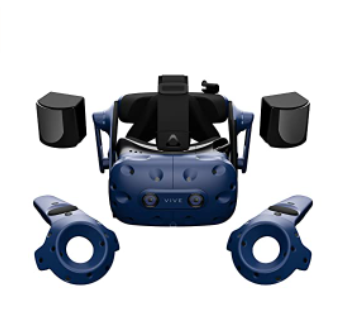
Key Features:
- Room-scale 22’11” x 22’11”
- 2 x 4 x 8 inches in size
- A compelling video game
- 3.82-pound weight
- Included are four lithium polymer batteries
Pros
- High-resolution Graphics.
- The sound quality is excellent.
- The construction is sturdy and comfortable.
Cons
- It does not include the motion controllers required for it to work
Another great VR headset for PC is the HTC VIVE Pro, which is designed for professional-grade VR applications. It allows you to immerse yourself in your favorite virtual reality games. A high-resolution AMOLED screen with a refresh rate of 90 Hz is included in the VR. HTC VIVE PRO has a pixel density of 615ppi due to its screen resolution of 2880 x 1600 pixels.
HTC has even included Hi-Res certified headphones with 3D spatial audio capabilities. It has the most up-to-date SteamVR tracking system, which tracks your movements in a 10 x 10-meter area and converts them to virtual reality. HTC VIVE has a field of view of 110 degrees, more significant than most headsets.
It has built-in microphones so you can communicate with your teammates crystal clear. The 360-degree dual control systems with HD haptic feedback add to the unique 3d. The HTC VIVE PRO includes Bluetooth and a USB Type-C port for seamless connectivity.
2-GOOGLE DAYDREAM
GOOGLE DAYDREAM
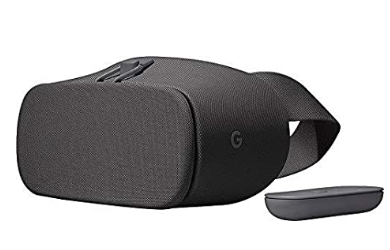
Key Features:
- 6.56 x 3.88 x 4.18″ Dimensions
- 1.35-pound weight
- A full 360-degree panorama
- 2 Inch Screen Size
- Display a screen with augmented reality
Pros
- Its Fantastic design makes use of soft fabric and a close fit.
- Combined with a user-friendly and precise controller
- It’s reasonably priced and compatible with a variety of headsets.
Cons
- The content library has a lot of ups and downs.
Google Daydream is a simple virtual reality headset that requires a Daydream-ready smartphone to enjoy high-quality immersive virtual reality content. Google Pixel, Moto Z, Moto Z Force, and Samsung Galaxy S8 are among the smartphones that support Daydream.
It comes with a remote from Google Daydream. Even when the smartphone is inside the headset, it puts all the controls at your fingertips. With a full 360-degree panoramic view, you can watch your favorite movies, TV shows, sports, etc.
Daydream is a lightweight virtual reality headset made of soft, breathable fabric that is comfortable and durable. Install the Daydream View app from the Google Play Store on your Android device. Make the most of Google’s virtual reality headset. Because of its ever-expanding library of apps and games.
3-Oculus Quest 2
Oculus Quest 2
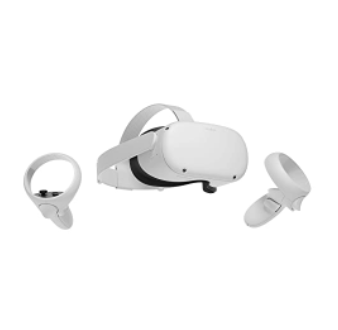
Key Features:
- Resolution 3664 x 1920 pixels
- USB-C, 3.5mm LCD connection
- 100° field of view
- 10.24 x 7.36 x 4.96 inches in size
- 1.83-pound weight
- 4 AA batteries are necessary
Pros
- There’s no need for an expensive computer.
- Tethering with the Oculus Link is now possible.
- The most competitive price on the market.
Cons
- A Facebook account is required.
For a good reason, the Oculus Quest 2 is the most well-known VR headset on the market right now. With a cable-free headset (which can also be tethered to your PC for a performance boost) and a massive collection of games and apps for a great price, the $299 / £299 device offers the best value shelves. Whether you’re new to virtual reality or a seasoned veteran looking for a more affordable option, the Oculus Quest 2 is excellent for a low-cost, high-quality experience.
With no limiting tracking area and a highly flexible setup, you’re free to roam your surroundings. It is a self-contained, all-in-one computer with a fast processor and plenty of RAM to play today’s games. That means you won’t need to invest in a high-end gaming PC to keep things running smoothly – you’ll be ready to play right away. And it isn’t easy to overstate how important that is to the value of Oculus Quest 2.
With so many of the best VR headsets under 10,000 (and still requiring a separate PC brain to function), cramming the tracking features, high-resolution display, 90Hz framerate, and comfortable experience into a sub-$300 price point is a huge accomplishment. We’ve also noticed an increase in Oculus Quest 2 deals in recent months.
4- HTC Vive Pro 2
HTC Vive Pro 2
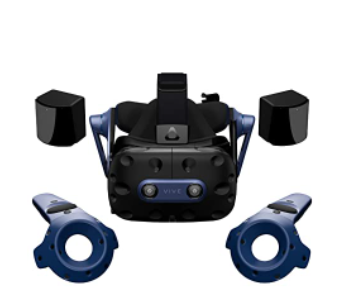
Key Features:
- 4896 x 2448 pixel resolution
- USB 3.0, Display Port 1.2
- 120° field of view
- 20.9 x 13.6 x 7.3 inches in size
- 13-pound weight
- Included are two Lithium Polymer batteries
Pros
- Outstanding performance.
- The highest resolution available on the market
- An extensive game library is open.
Cons
- It has a reputation for heating up quickly.
If you’re looking for the best VR headset money can buy, we recommend the HTC Vive Pro 2. It is a big kids’ toy, with a price tag of $800 for the headset alone, not including the additional accessories and high-end PC. The HTC Vive Pro 2’s 4896 x 2448 resolution, pinpoint motion tracking, and Steam VR integrations, on the other hand, make it a must-see for specialists and budget-conscious enthusiasts.
That resolution is at the top of the current market, providing ultra-clear visuals that aren’t available on lower-cost headsets. You’re tethered to a PC via a Link Box connection, so tripping is possible if you get up and about.
For the whole experience, you’ll need two Steam VR base stations and motion controllers, which will set you back around 10,000. However, once you do, you’ll have access to a new level of tracking and motion that other VR headsets may struggle to match unless they do so at the expense of other features.
The incredible resolution, combined with the 120° field of view and refresh rate of up to 120Hz, is the main draw here. It is where the piggy bank should go if you’re going all-in on a future-proofed setup and want your games to look as good as they possibly can while doing so.
5- EPOS Audio H6PRO Gaming Headset
EPOS Audio H6PRO Gaming Headset
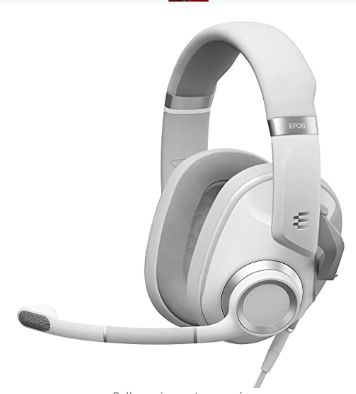
Key Features:
- 9.45 x 8.66 x 10.83 inches in size
- 11.4 ounces in weight
- 42 mm drivers
- 3.5 mm connector
- Bidirectional microphone
Pros
- The sound is well-balanced and detailed.
- There are both open-back and closed-back versions available.
- A microphone is detachable and has a mute switch.
- Excellent construction quality.
Cons
- The braided cable is a little challenging to work with EPOS.
The H6PRO is Epos’ new gaming flagship, and it builds on the core concept of the Epos H3 headset while improving it slightly. That is to say, the headset looks very similar to the other Epos headsets, but it has a few new features that are worth considering if you’re looking for a new gaming headset.
The H6PRO is available in two configurations: open-back and closed-back. The difference will affect the noise isolation, audio response, and how the headset feels on your head. So, in terms of gaming headset features, you could say it’s a big decision.
When it comes to wired connectivity, the H6PRO is relatively standard. The headset is connected to your PC, console, or other devices via a 2.5m braided 3.5mm analog cable. The included cable is sturdy, long-lasting, and quiet but stiff. To keep it out of the way, frequently tuck it under the keyboard. We are hoping that the cable will loosen up with more use, but we can’t help but think that the braided cable belongs on other PC peripherals, not on my high-end gaming headset.
Conclusion
The good news is that you don’t have to spend a fortune on a fantastic virtual reality headset! There are plenty of VR headsets under 10,000 that provide all of the immersive fun that high-end equipment does. Check out the top 5 best VR headsets under 10,000 in the table above to see which one is right for you!
Frequently Asked Questions
Q: Is a phone required for all VR headsets?
A: Standalone virtual reality headsets are all-in-one devices that can run virtual reality without needing a computer or a phone. After six years, there is a slew of standalone VR headsets, with more in the coming months.
Q: Do virtual reality headsets harm your eyes?
A: The BBC investigated this claim, speaking with a representative from the Association of Optometrists, who stated that there is currently no evidence that VR headsets cause permanent vision damage. We get the same type of temporary eyestrain from staring at a computer screen for too long.
Q: Do I need glasses when using virtual reality?
A: According to the official documentation, Oculus recommends glasses with a width of 142mm and a height of 50mm or less. However, anything more significant than that will certainly not fit in the Quest 2 or most other headsets.
